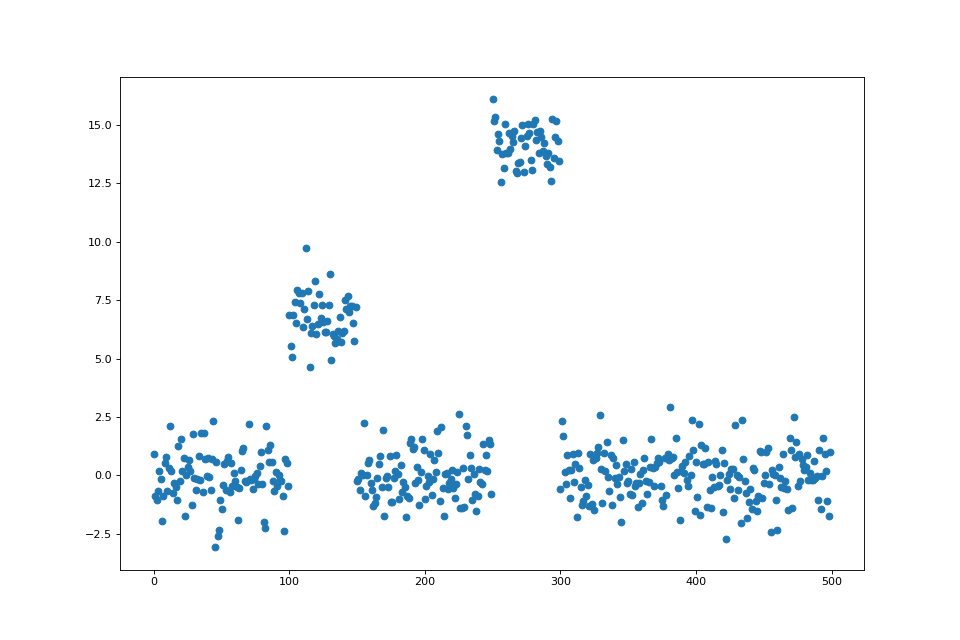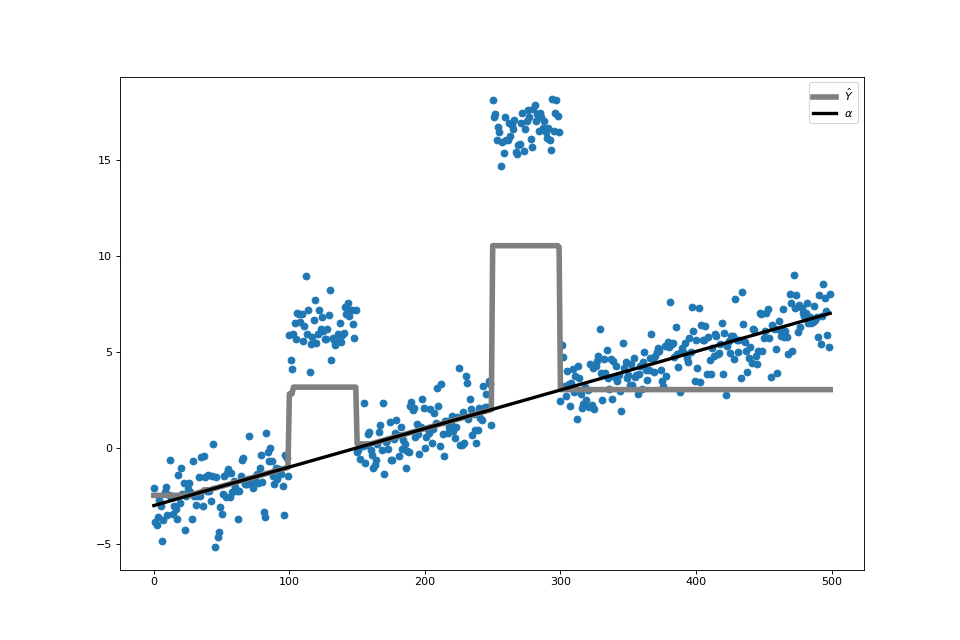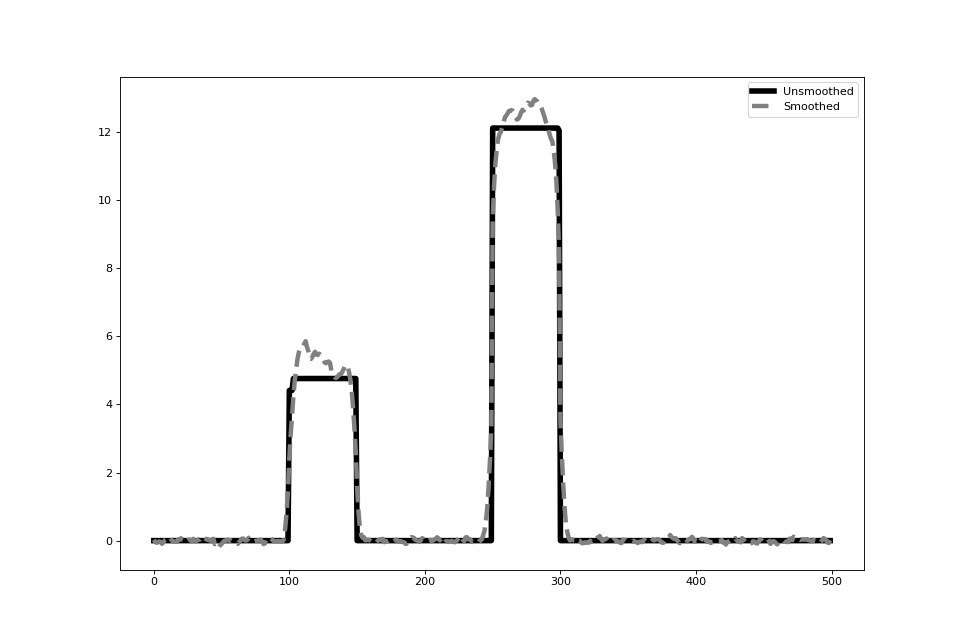Using constraints¶
This tutorial illustrates how to use RegReg to solve problems using the container class. We illustrate with an example:
This problem is solved by solving a dual problem, following the general derivation in the TFOCS paper
Recall that for the sparse fused LASSO
To solve this problem using RegReg we begin by loading the necessary numerical libraries
Hint
If running in the IPython console, consider running %matplotlib to enable
interactive plots. If running in the Jupyter Notebook, use %matplotlib
inline.
import matplotlib.pyplot as plt
import numpy as np
from scipy import sparse
import regreg.api as rr
from regreg.affine.fused_lasso import difference_transform
Next, let’s generate an example signal, and solve the Lagrange form of the problem
fig = plt.figure(figsize=(12,8))
ax = fig.gca()
Y = np.random.standard_normal(500); Y[100:150] += 7; Y[250:300] += 14
ax.scatter(np.arange(Y.shape[0]), Y)

loss = rr.signal_approximator(Y)
sparsity = rr.l1norm(len(Y), lagrange=1.4)
D = difference_transform(np.arange(Y.shape[0]))
fused = rr.l1norm.linear(D, lagrange=15.5)
fused
problem = rr.dual_problem.fromprimal(loss, sparsity, fused)
problem
solution = problem.solve(tol=1.e-14)
ax.plot(solution, c='yellow', linewidth=5, label='Lagrange')
fig
We will now solve this problem in constraint form, using the achieved values \(\delta_1 = \|D\widehat{\beta}\|_1, \delta_2=\|\widehat{\beta}\|_1\). By default, the container class will try to solve this problem with the two-loop strategy.
delta1 = np.fabs(D * solution).sum()
delta2 = np.fabs(solution).sum()
fused_constraint = rr.l1norm.linear(D, bound=delta1)
sparsity_constraint = rr.l1norm(Y.shape[0], bound=delta2)
constrained_problem = rr.dual_problem.fromprimal(loss,
fused_constraint, sparsity_constraint)
constrained_problem
constrained_solution = constrained_problem.solve(tol=1.e-12)
ax.plot(constrained_solution, c='green', linewidth=3, label='Constrained')
fig
Mixing penalties and constraints¶
As atoms generally have both bound form and Lagrange form, we can solve problems with a mix of the two penalties. For instance, we might try minimizing this objective
mixed_problem = rr.dual_problem.fromprimal(loss, fused_constraint, sparsity)
mixed_problem
mixed_solution = mixed_problem.solve(tol=1.e-12)
ax.plot(mixed_solution, '--', linewidth=6, c='gray', label='Mixed')
ax.legend()
fig
np.fabs(D * mixed_solution).sum(), fused_constraint.atom.bound
(33.67439163971784, 33.674299924228016)
Atoms have affine offsets¶
Suppose that instead of shrinking the values in the fused LASSO to 0, we want to shrink them all towards a given vector \(\alpha\)
This can be achieved, at least conceptually by minimizing
with
Everything is roughly the same as in the fused LASSO, we just need to change the second seminorm to have this affine offset.
Now we can create the problem object, beginning with the loss function
alpha = np.linspace(0,10,500) - 3
shrink_to_alpha = rr.l1norm(Y.shape, offset=alpha, lagrange=3.)
shrink_to_alpha
which creates an affine_atom object with \(\lambda_2=3\). That is, it creates the penalty
that will be added to a smooth loss function. Next, we create the fused lasso matrix and the associated l1norm object,
Here we first created D, converted it a sparse matrix, and then created an l1norm object with the sparse version of D and \(\lambda_1 = 25.5\). Finally, we can create the final problem object, and solve it.
loss_alpha = rr.signal_approximator(Y + alpha)
fig_alpha = plt.figure(figsize=(12,8))
ax_alpha = fig_alpha.gca()
alpha_problem = rr.dual_problem.fromprimal(loss, shrink_to_alpha, fused)
alpha_solution = alpha_problem.solve(tol=1.e-14)
ax_alpha.scatter(np.arange(Y.shape[0]), Y + alpha)
ax_alpha.plot(alpha_solution, c='gray', linewidth=5, label=r'$\hat{Y}$')
ax_alpha.plot(alpha, c='black', linewidth=3, label=r'$\alpha$')
ax_alpha.legend()

We can then plot solution to see the result of the regression,
Atoms can be smoothed¶
Atoms can be smoothed using the same smoothing techniques described in NESTA and TFOCS
Recall that the sparse fused lasso minimizes the objective
The penalty can be smoothed to create a smooth function object which can be solved with FISTA.
Q = rr.identity_quadratic(0.1, 0, 0, 0)
smoothed_sparsity = sparsity.smoothed(Q)
smoothed_sparsity
smoothed_fused = fused.smoothed(Q)
problem = rr.smooth_sum([loss, smoothed_sparsity, smoothed_fused])
solver = rr.FISTA(problem)
solver.fit(tol=1.e-10)
smooth_solution = solver.composite.coefs.copy()
smooth_fig = plt.figure(figsize=(12,8))
smooth_ax = smooth_fig.gca()
smooth_ax.plot(solution, 'k', linewidth=5, label='Unsmoothed')
smooth_ax.plot(smooth_solution, '--', c='gray', linewidth=4, label='Smoothed')
smooth_ax.legend() #doctest: +ELLIPSIS

which has both the loss function and the seminorm represented in it. We will estimate \(\beta\) for various values of \(\epsilon\):
solns = []
for eps in [.5**i for i in range(15)]:
Q = rr.identity_quadratic(eps, 0, 0, 0)
smoothed_sparsity = sparsity.smoothed(Q)
smoothed_fused = fused.smoothed(Q)
problem = rr.smooth_sum([loss, smoothed_sparsity, smoothed_fused])
solver = rr.FISTA(problem)
solver.fit(tol=1.e-10)
solns.append(solver.composite.coefs.copy())
smooth_ax.plot(solns[-1], '--')
smooth_fig
Of course, we don’t have to smooth both atoms. We could just smooth the fused term.
smoothed_fused_constraint = fused_constraint.smoothed(rr.identity_quadratic(1e-3,0,0,0))
smooth_part = rr.smooth_sum([loss, smoothed_fused_constraint])
smoothed_constrained_problem = rr.simple_problem(smooth_part, sparsity_constraint)
smoothed_constrained_solution = smoothed_constrained_problem.solve(tol=1e-12)
ax.plot(smoothed_constrained_solution, c='black', linewidth=1, label='Smoothed')
ax.legend()
fig